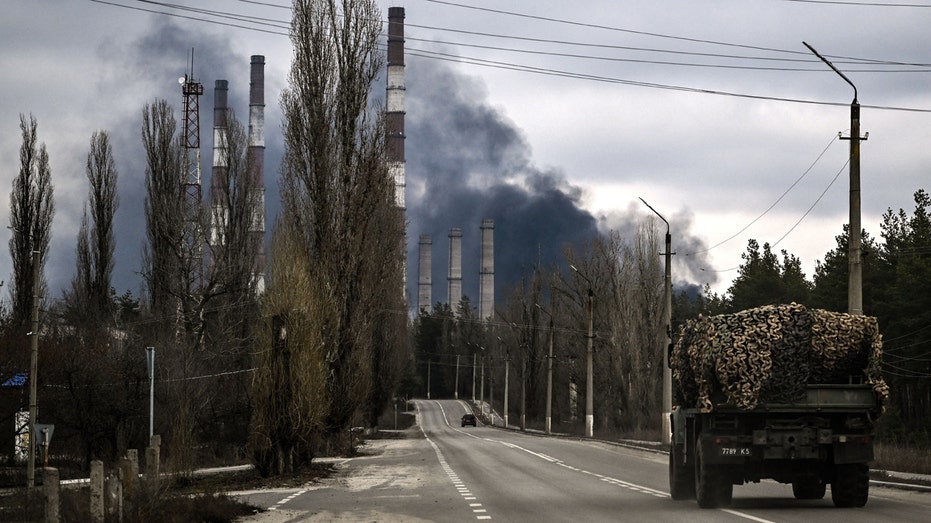Ukraine-Russia conflict could push inflation to 10% as invasion begins
Escalating Russia-Ukraine crisis could push oil prices to $120 a barrel
Outlook for oil as Russia invades Ukraine
Price Futures Group senior market analyst Phil Flynn discusses how the Russian invasion of Ukraine will impact oil prices.
U.S. inflation is already at the highest level in four decades. Russia's full-scale attack on Ukraine could push it even higher.
That's because the conflict has already sent oil prices above $100 a barrel for the first time since 2014, with some prices jumping as high as $105 on Thursday after Russia launched a broad offensive against Ukraine late Wednesday night, hitting cities and bases with airstrikes and shelling. Brent crude, the global benchmark, surged more than 8%, hitting $105.50 early Thursday. U.S. oil prices, meanwhile, climbed to more than $99.
LIVE UPDATES: WORLD REACTS AS PUTIN ORDERS TROOPS INTO UKRAINE
The war in Europe – which has shattered nearly three decades of peace on the continent – could ultimately cause oil prices to surge as much as 20% to $120 a barrel, according to RSM chief economist Joe Brusuelas. Should that happen, consumer prices in the U.S. would surge above 10% on an annual basis, the economist said, the highest since October 1981.
The conflict also threatens to cause massive casualties.

Smoke rises from a power plant after shelling outside the town of Schastia, near the eastern Ukraine city of Luhansk, on Feb. 22, 2022. (Aris Messinis/AFP via Getty Images / Getty Images)
"The potential for a broader energy shock to the global and U.S. economies should Russia invade Ukraine has added to a combustible mix of factors that is causing inflation to accelerate in the United States and abroad," Brusuelas said. "That risk carries with it the potential to slow down growth."
Russia is the world's second-largest producer of both oil and natural gas; a conflict or sanctions could disrupt the oil market even further at a time when high demand is outpacing tight supplies. The Organization of the Petroleum Exporting Countries and other oil-producing nations, together known as OPEC+, have resisted calls to boost supply.
Germany already halted the certification of the Nord Stream 2 gas pipeline from Russia, while the U.S. and the European Union have also levied harsh financial sanctions against Moscow after it recognized two breakaway regions in eastern Ukraine. Additional sanctions are expected after Russia launched a wide-ranging attack on Ukraine that threatens to upend the geopolitical order and reverberate throughout the rest of the world.
Russian President Vladimir Putin threatened that any foreign country attempting to interfere will be hit with "consequences you have never seen" – a chilling reference to Moscow's nuclear arsenal. American and European officials also fear that Russia may retaliate against the sanctions by cutting off the supply of oil and natural gas that flows from Moscow to Europe, sending prices spiraling higher.
Ukrainian President Volodymyr Zelenskyy cut diplomatic ties with Russia and declared martial law.
"As of today, our countries are on different sides of world history," Zelenskyy tweeted. "Russia has embarked on a path of evil, but Ukraine is defending itself and won’t give up its freedom."
Although the invasion sparked fresh jitters about the possibility of a new world war, the U.S. and its NATO allies have so far shown no indication that they would join the war against Russia.

Russian President Vladimir Putin speaks as he attends the G20 summit via videoconference in Moscow, Russia, on Oct. 30, 2021. (Evgeniy Paulin, Sputnik, Kremlin Pool Photo via AP / AP Newsroom)
JPMorgan Chase economists have warned that any disruption to Russia's supplies could "easily" send oil to $120 a barrel.
U.S. consumers are already facing sticker shock at the pump: A gallon of gas, on average, cost $3.51 nationwide on Tuesday, according to AAA – up from $2.63 a year ago. In California, gas prices are well over $4 per gallon.
RUSSIA SANCTIONED AFTER PUTIN RECOGNIZES REBEL-HELD PROVINCES IN UKRAINE
For months, the prices of all kinds of energy – gasoline, diesel fuel, natural gas, oil and more – have been a major driver behind inflation, which surged 7.5% in January, the highest level since 1982. Energy costs have climbed 27% over the past year, in part due to lopsided supply and demand. Consumers are traveling more, but the supply side has not kept up with the demand.





















